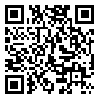Volume 64, Issue 8 (13 2006)
Tehran Univ Med J 2006, 64(8): 103-109 |
Back to browse issues page
Download citation:
BibTeX | RIS | EndNote | Medlars | ProCite | Reference Manager | RefWorks
Send citation to:



BibTeX | RIS | EndNote | Medlars | ProCite | Reference Manager | RefWorks
Send citation to:
Salimi J, Taghavi M, Shojaeefar A, Shadman F. Management of Infected femoral pseudoaneurysm in intravenous drug abusers. Tehran Univ Med J 2006; 64 (8) :103-109
URL: http://tumj.tums.ac.ir/article-1-918-en.html
URL: http://tumj.tums.ac.ir/article-1-918-en.html
Abstract: (6157 Views)
Background: A plan for management of infected arterial pseudoaneurysm has evolved from our experience with forty two cases of such aneurysms treated between 1378 and 1382.
Methods: Clinical data of 42 patients with femoral pseudoaneurysm resulting from addictive drug injection who presented in emergency department of Sina Hospital between 1378 and 1383 were retrospectively reviewed.
Results: All patients were men with the mean age of 36.9 years. Twenty eight patients were referred from other medical centers. The mean time of delay in presentation was 17.3 days. The mean duration of drug injection was 14 months. Primary repair and emergent vascular bypass were performed in 3(7.1%) and 2(4.8%) patients, respectively. 5(11.9%) patients undergone delayed revascularization. Thirty two (76.2%) patients returned to their normal lifestyle without any vascular bypass. One patient required amputation and one patient died due to sepsis and acute renal insufficiency.
Conclusion: Management of infected femoral pseudoaneurysms is simple ligation of the external iliac or femoral artery. When Doppler is not available “Operation Room and postoperative Direct Observation” is recommended in such patients to avoid unnecessary revascularization surgery.
Methods: Clinical data of 42 patients with femoral pseudoaneurysm resulting from addictive drug injection who presented in emergency department of Sina Hospital between 1378 and 1383 were retrospectively reviewed.
Results: All patients were men with the mean age of 36.9 years. Twenty eight patients were referred from other medical centers. The mean time of delay in presentation was 17.3 days. The mean duration of drug injection was 14 months. Primary repair and emergent vascular bypass were performed in 3(7.1%) and 2(4.8%) patients, respectively. 5(11.9%) patients undergone delayed revascularization. Thirty two (76.2%) patients returned to their normal lifestyle without any vascular bypass. One patient required amputation and one patient died due to sepsis and acute renal insufficiency.
Conclusion: Management of infected femoral pseudoaneurysms is simple ligation of the external iliac or femoral artery. When Doppler is not available “Operation Room and postoperative Direct Observation” is recommended in such patients to avoid unnecessary revascularization surgery.
| Rights and permissions | |
 |
This work is licensed under a Creative Commons Attribution-NonCommercial 4.0 International License. |





